© All Rights Reserved.
Jalebi recipe | Zoolbia, Preparing Zoolbia at home in a confectionery style in 9 steps
Jalebi or Zoolbia is a completely different and separate sweet from Bamiyeh (Bamieh), which is another sweet, but usually, these two sweets are bought and eaten together. Along with these two sweets, the combination of gooshfil is also used.
But where did these sweets come from and when were they eaten together, is a really amazing questions we answer in the rest of the text in the Cookery Magazine.
Ingredients for making Jalebi syrup
| Sugar | 2 ⭐️glasses (or cup) |
| Brewed saffron | 1 tablespoon |
| Rose water | ¼ glass |
| Water | 1.5 glasses |
| Lemon juice | ½ teaspoon |
⭐️Choose 1 unit of measurement and continue with it until the end
Recipe for making Jalebi | Zoolbia syrup
The first step
To prepare a delicious honey syrup, first pour water into a suitable pot and put it on the flame, reduce the heat add sugar little by little, and stir it with a spoon until the sugar is completely dissolved in water.
The second step
Of course, we have to stir the syrup slowly so that the syrup does not hit the walls of the pot too much.
Then we add the brewed saffron and immediately add lemon juice and rose water and wait until the syrup reaches its consistency.
The third step
After the syrup thickens a little, we turn off the heat and leave the pot aside until the syrup cools down.
(The syrup will become thicker after cooling, so don’t let it thicken too much) We put the syrup in the refrigerator to cool down for preparing zolbia.
(In the second step, if you want and as you desire, you can add a tablespoon of cardamom to your mixture)
Ingredients for making Jalebi
| White flour | 1 tablespoon |
| Rose water | 1 tablespoon |
| Cardamom essential oil | 2 drops |
| Starch | 50 grams |
| Yogurt | ¼ glass |
| Butter | ½ teaspoon |
| Baking soda | ¼ teaspoon |
| Liquid oil | As much as needed |
Recipe for making Jalebi
The first step
To prepare homemade jalebi, first, we take the butter and yogurt out of the refrigerator so that it adapts to the ambient temperature. Pour yogurt into a bowl and add starch to it mix them with a hand mixer and leave this mixture aside for 5 minutes.
The second step
We sift the flour and add it to the mixture of yogurt and starch After 5 minutes mix the ingredients with a spoon and add softened butter to the ingredients and add baking soda, rose, cardamom essence. .
The third step
Now we mix all the ingredients well with a hand mixer so that our sauce has a consistency similar to yogurt.
(If the mixture is a little stiff, you can add a little rose water again) In a medium pan, we float the oil for frying.
The fourth step
Then we put the pan on a medium flame and let the oil get hot over time with low heat. We put the funnel in a glass and pour the Zoolbia mixture into it and when the oil gets hot, hold the funnel in our hands.
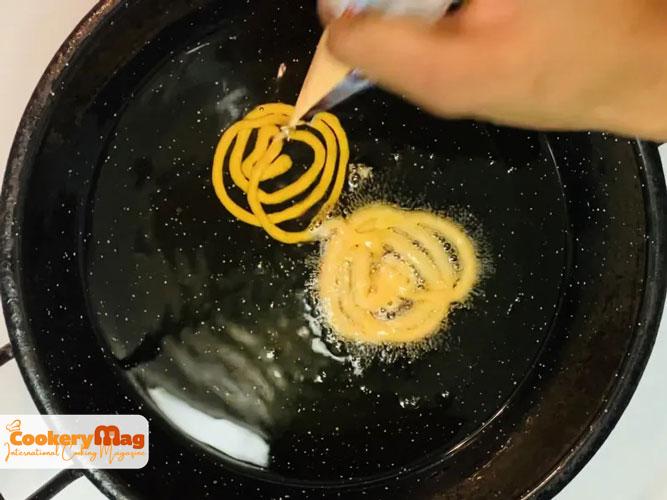
The fifth step
Now we press it very quickly until the liquid comes out then we move our hand in a circle way and press the funnel until the liquid is continuously poured into the oil and a circle is formed inside the oil and then we pause and create another circle in oil.
The sixth step
In the same way, we shape the zolbias in the oil and with a slotted spatula, we return the zolbias into the oil until both sides are golden and completely fried.
(You can also pour the sauce into the sauce’s can instead of the funnel)
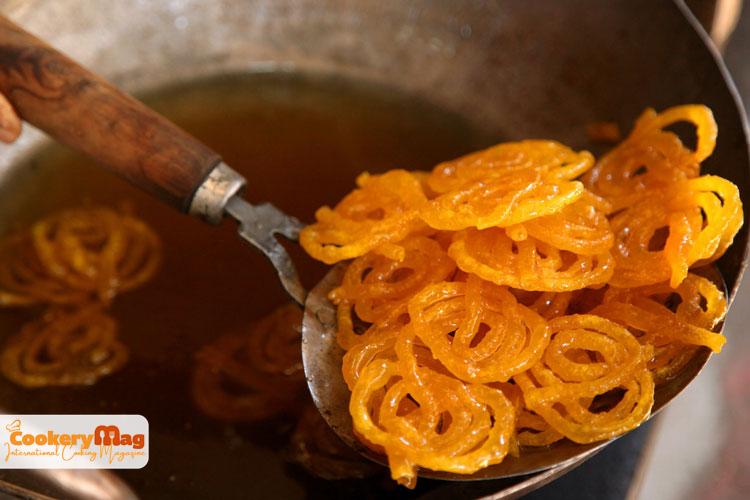
The seventh step
We take out the syrup from the refrigerator. When the zolbias are red and golden, we take them out of the oil and put them in a net for 1 minute to remove their excess oil, and then put them in the cold syrup (as we explained its preparation).
The eighth step
Now we let the zoolbias stay in the syrup for 2-3 minutes until they are completely soaked in the syrup, and then we put them in a net again to remove the excess syrup. We put the prepared zoolbias in the desired container.
The ninth step

Now cover the container with cellophane and put it in the refrigerator to cool down.
If you plan to make bamieh along with Zoolbia, put the syrup back in the refrigerator after use so that it cools down for the next sweet.
Having a journey in the history of Zoolbia
If we want to look at the reasons why such a sweet was created in a more logical way, we must say that it is not possible to declare a specific time for the genesis and appearance of Jalebi, and the only source of it is the experiences and statements of the old masters of this profession.
Even some of the old masters consider Jalebi to be related to the time of Shah Abbas (Abbas the Great).
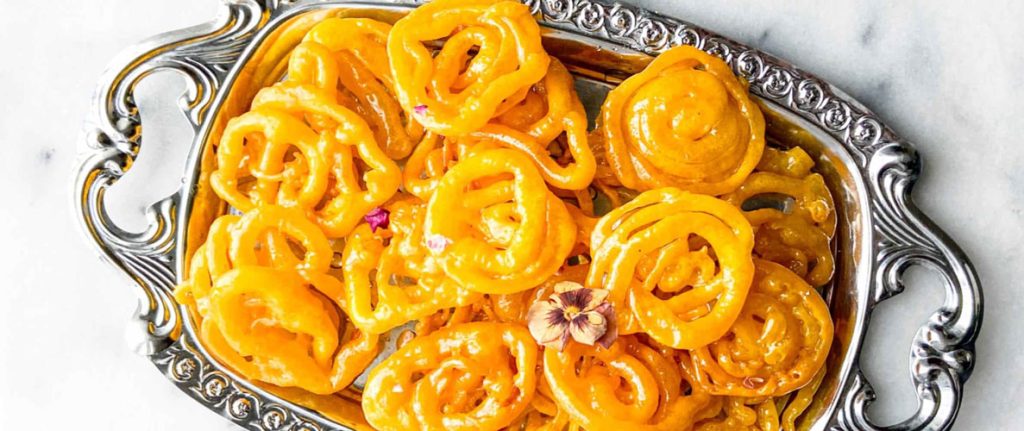
Considering that in some cities of Iran, sweets such as raisins and dates were not available, sweet Foodstuffs and nutrients were not available in various forms and were not cultivated due to weather conditions, and there were problems such as spoilage to take these ingredients to other cities.
This is why the production of Jalebi or zoolbia expanded in cities where there were no sweets.
Sweets such as zulbiya and bamieh were in the category of those sweets that did not need to be stored under cold weather and for a certain period of time, and for this reason, the possibility of sending these sweets to other cities was high.
With the investigations that have been done, in the books that were about recording the events of the Qajar court; It has been discovered that jalebi were brought from India to Iran during the time of Naser al-Din Shah due to his interest in this food.
Contrary to many people who thought that these sweets belong to Türkiye because of the huge amount of sugar syrup, but they are believed to have originated in India, Ethiopia, or Iran.

Jalebi with bamieh is two special sweets for the month of Ramadan that Mozafaruddin Qajar sometimes nags: “I am waiting for the month of Ramadan to satisfy my craving for jalebi and bamieh“.
The story of Muzaffaruddin Shah Qajar and Zulbia’s lust by Jafar Shahri in the book “Social History of Tehran in the 13th Century” is as follows:
Muzaffaruddin Shah was spoken when some foods were not in season. For example, before Nowruz arrived, he would say, “Nowruz is coming, let’s eat rice” or when it wasn’t time for zolbia and okra, he would say, “When will Ramadan come, let’s eat zoolbia and Bamieh.”
Muzaffaruddin Shah used to say constantly and continuously: «When the month of Ramadan will come so that we can eat jalebi.
As he said, if Nowruz comes, we will eat rice and winter is the same for the rich and the poor».
In the sense in Ramadan, finally, anyone can eat jalebi, even if it is at a party or someone else’s house, and in the same way, the pilaf on the night of Eid, where even a poor person can make it with pour five *sir of rice into the water, and the winter water is also cold and it is like the cool water that the rich drank in the summer, which expresses the proverb the water of a king and a beggar are the same in winter.
⭐️Sir: The unit of weight measurement in old Iran is equal to 75 grams, which here is 375 grams.

In the old days, food was not kept in greenhouses and cold storages as now that are available in every season of the year. Everything had its season.
Usually, indulgent foods came in their season, that is, the season and time were known for them, like Zoolbiya and bamieh, which only came in the month of Ramadan, and that’s it, and at other times, it was replaced by Baghlava.

Of course, up to this point, one more question and answer will be crystal clear.
The question was, has it ever occurred to you to think that even though there are three types of sweets for the month of Ramadan, the names of Zoolbiya and bamieh are mentioned always together, and gooshfil are mentioned separately?
The answer to this is clear because the royal words of Shah Qajar threw this term on the tongues of people from that time and it has remained the same until now.
Zoolbia is usually made with starch, yogurt, flour, saffron, oil, rose water, and sugar, and its roots probably reached 500 years ago in India.
Although some have considered the origin of this sweet to be Iran or Türkiye.
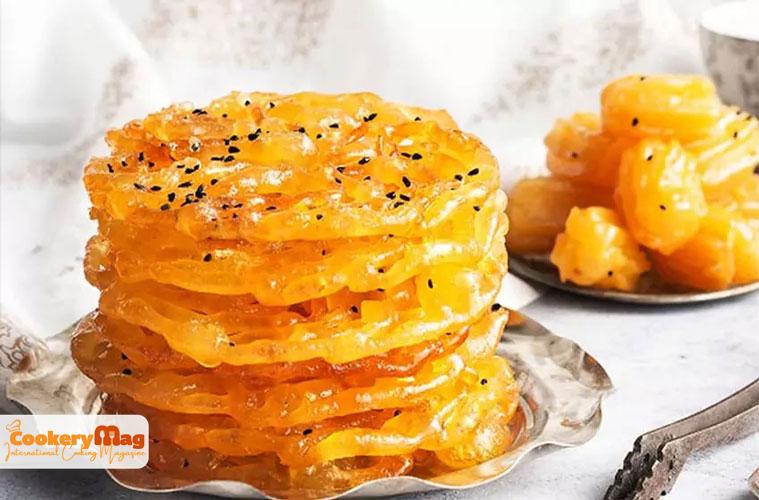
With a simple calculation, we can understand that nearly 150 years have passed since the life of popular sweets these days, but we must tell you that the method and form of baking these sweets are still the same as the years when this sweet was invented. !
Today, some pastry shops apply a series of changes in cooking zoolbia, such as adding different flavors, but nearly 90% of pastry shops throughout Iran, cook this pastry in the same original way.
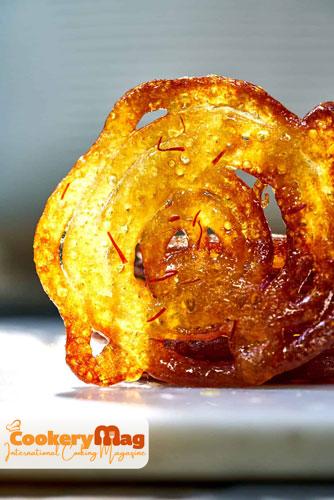
In the book “Mustatab Cooking from A to Z” written by Najaf Daryabandari in collaboration with Fahime Rastkar (his wife), it is stated:
The shape of the jalebi (Zulbia) has changed in recent years.
Zoolbia today in Tehran is usually a hand-sized, burnt honey-colored round net with thin and fragile rods, which was called Tabrizian Zoolbia or Boshghabi (plate size | بشقابی) in the past.
But until one or two decades ago, zoolbia was something the size of a light yellow saucer, some of which were burnt honey-colored and straw-like, with sticks as thick as pencils and somewhat soft (this zolbia is still in some cities such as Mashhad, Isfahan is prepared).
Some of the special taste of the old zolbia was from sesame oil, which was always used in cooking, but nowadays sesame oil is too expensive to be used only in baking.
Of course, the dominance of Tabrizian Zoolbia over Tehrani Zolbia is natural, but the loss of Zolbia diversity in Tehran is not a good thing.

In Arab countries, Zulbia is called “Zalabiyyeh” and in India, it is called “Jelebi”.
The ingredients of Arabic zoolabia and Indian jalabi are close to each other and are slightly different from Iranian zolabia; Probably the Iranians of the Qajar period invented flour, eggs, oil, sugar, and rose water.
Adding this condiment worked, and all kinds of bamieh (Bamiyeh) came to the market, some of which were not even cooked for the month of Ramadan. Of course, another opinion is that bamieh came from Syria or Turkey.
Bamieh was the street market sweet of Tehranians for about a century, and until 2 decades ago, especially in Tehran markets, itinerant bamiyeh sellers were seen with a big tray on their heads.
Frequently Asked Questions about zulbia
What is the name of zoolbia that is cooked and served in Iran today?
Zolbiai, which is cooked in Iran today, was called Tabrizian Zulbia or Boshghabi in the past.
Why our zoolbia get so hard and dry?
You made Zolbia very thin, You fried Zulbia too much or You used too much flour.
Zoolbia
Course: Afghan Food, Persian FoodCuisine: sweetDifficulty: Medium6
servings40
minutes10
minutes0/450
kcalRamadan part of Muslims table, an authentic indian sweet.
Ingredients
White flour, 1 tablespoon
Rose water, 1 tablespoon
Cardamom essential oil, 2 drops
Starch, 50 grams
Yogurt, ¼ cup
Butter, ½ teaspoon
Baking soda, ¼ teaspoon
Liquid oil, As much as needed
- For the syrup
Sugar, 2 ⭐️glasses (or cup)
Brewed saffron, 1 tablespoon
Rose water, ¼ glass
Water, 1.5 glasses
Lemon juice, ½ teaspoon
Directions
- Recipe for making the syrup
- The first step
To prepare a delicious honey syrup, first pour water into a suitable pot and put it on the flame, reduce the heat add sugar little by little, and stir it with a spoon until the sugar is completely dissolved in water. - The second step
Of course, we have to stir the syrup slowly so that the syrup does not hit the walls of the pot too much.
Then we add the brewed saffron and immediately add lemon juice and rose water and wait until the syrup reaches its consistency. - The third step
After the syrup thickens a little, we turn off the heat and leave the pot aside until the syrup cools down.
(The syrup will become thicker after cooling, so don’t let it thicken too much) We put the syrup in the refrigerator to cool down for preparing zolbia. - Direction for main recipe of jalebi
- The first step
To prepare homemade jalebi, first, we take the butter and yogurt out of the refrigerator so that it adapts to the ambient temperature. Pour yogurt into a bowl and add starch to it mix them with a hand mixer and leave this mixture aside for 5 minutes. - The second step
We sift the flour and add it to the mixture of yogurt and starch After 5 minutes mix the ingredients with a spoon and add softened butter to the ingredients and add baking soda, rose, cardamom essence. - The third step
Now we mix all the ingredients well with a hand mixer so that our sauce has a consistency similar to yogurt.
(If the mixture is a little stiff, you can add a little rose water again) In a medium pan, we float the oil for frying. - The fourth step
Then we put the pan on a medium flame and let the oil get hot over time with low heat. We put the funnel in a glass and pour the Zoolbia mixture into it and when the oil gets hot, hold the funnel in our hands. - The fifth step
Now we press it very quickly until the liquid comes out then we move our hand in a circle way and press the funnel until the liquid is continuously poured into the oil and a circle is formed inside the oil and then we pause and create another circle in oil. - The sixth step
In the same way, we shape the zolbias in the oil and with a slotted spatula, we return the zolbias into the oil until both sides are golden and completely fried. (You can also pour the sauce into the sauce’s can instead of the funnel) - The seventh step
We take out the syrup from the refrigerator. When the zolbias are red and golden, we take them out of the oil and put them in a net for 1 minute to remove their excess oil, and then put them in the cold syrup (as we explained its preparation). - The eighth step
Now we let the zoolbias stay in the syrup for 2-3 minutes until they are completely soaked in the syrup, and then we put them in a net again to remove the excess syrup. We put the prepared zoolbias in the desired container. - The ninth step
Now cover the container with cellophane and put it in the refrigerator to cool down. If you plan to make bamieh along with Zoolbia, put the syrup back in the refrigerator after use so that it cools down for the next sweet.
Conclusion
Thank you for being with us with this delicious and popular sweet recipe, jalebi. If you have any more questions, it’s my honor to answer. Enjoy your exploration of Persian cuisine!
Please share this article with your friends on Facebook, Twitter, Pinterest, and other social media. 🧡


